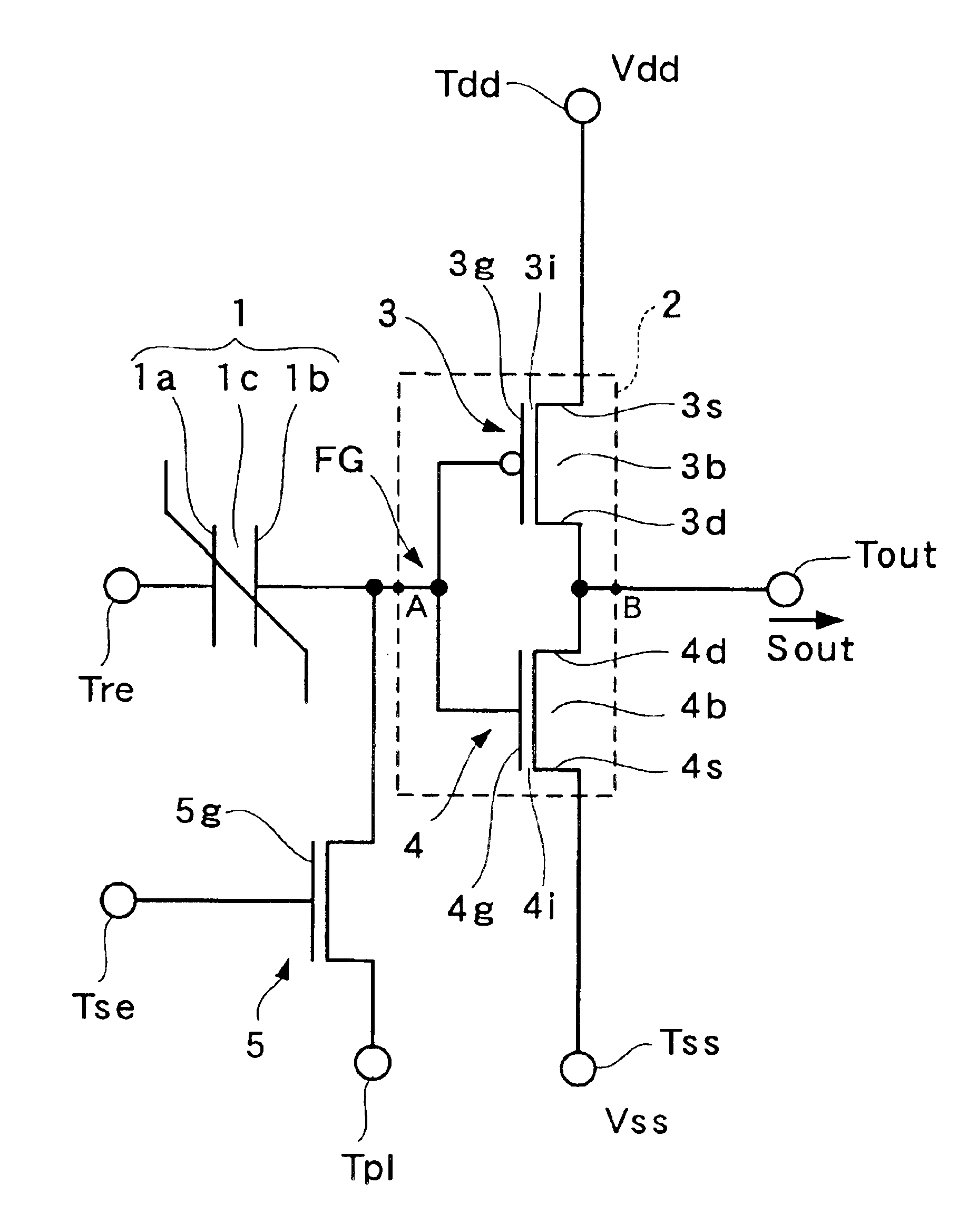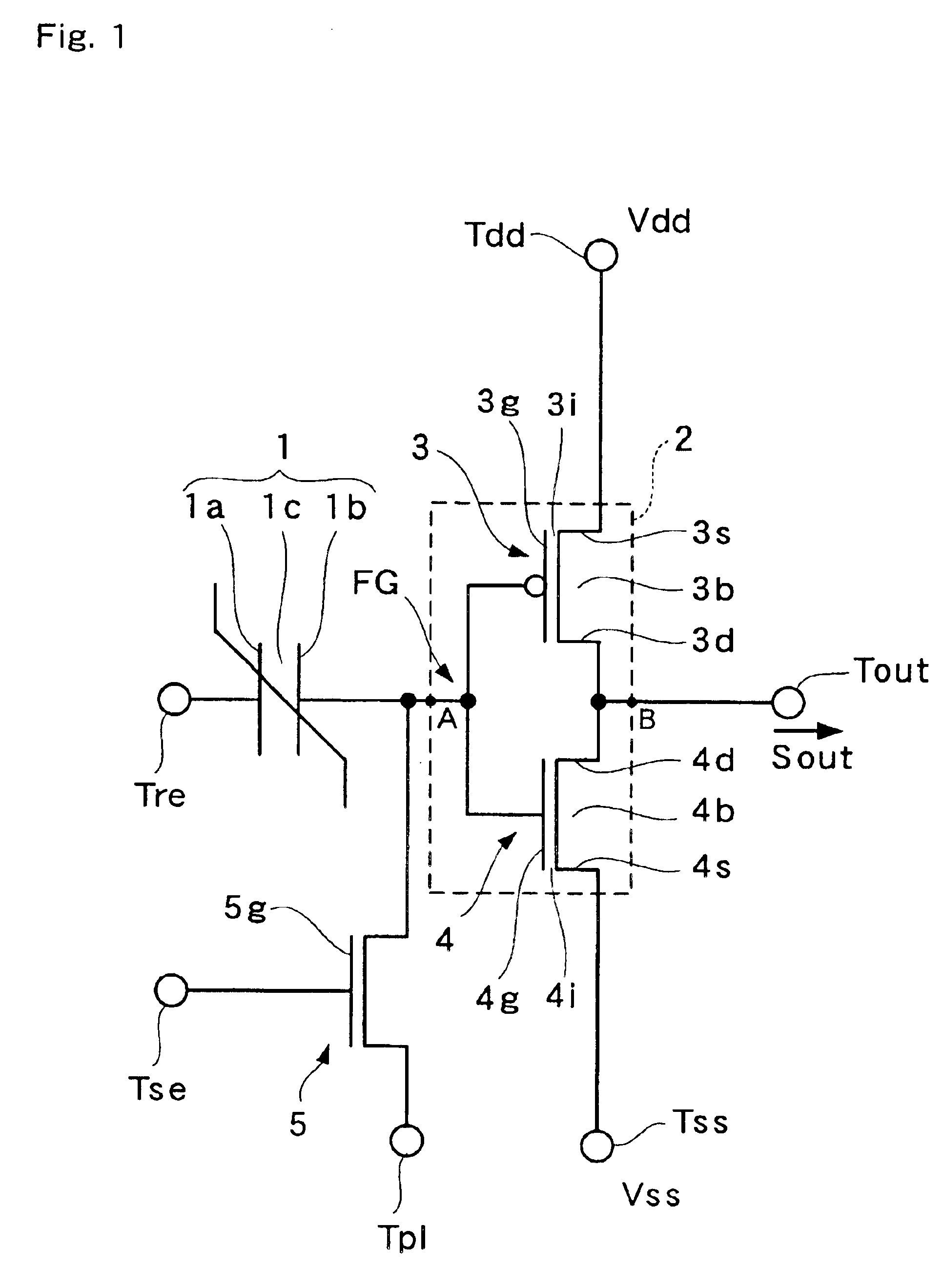Non-volatile latch circuit and a driving method thereof
a latch circuit and non-volatile technology, applied in the direction of pulse generators, pulse techniques, instruments, etc., can solve the problems of ferroelectric film properties deteriorating, power consumption also increasing, and power consumption increasing serious problems
- Summary
- Abstract
- Description
- Claims
- Application Information
AI Technical Summary
Benefits of technology
Problems solved by technology
Method used
Image
Examples
first embodiment
[0046
[0047]Hereunder, the first embodiment of the non-volatile latch circuit will be explained with reference to the drawings. FIG. 1 is a diagram schematically showing the structure of a non-volatile latch circuit of the present embodiment.
[0048]As shown in FIG. 1, non-volatile latch circuit 10 is provided with ferroelectric capacitor 1, CMOS inverter element 2, which comprises PMISFET 3 and NMISFET 4, and reset NMISFET 5.
[0049]Ferroelectric capacitor 1 is formed of first and second electrodes 1a and 1b, and ferroelectric film 1c inserted between first and second electrodes 1a and 1b. First electrode 1a is connected to reset terminal Tre (first input terminal), and second electrode 1b is connected to gate electrode 3g of PMISFET 3 and gate electrode 4g of NMISFET 4 through conductive members, such as a plug and electric wiring. There are many examples of ferroelectric materials that can form ferroelectric film 1c, for example, strontium bismuth tantalate (Y1: SrBi2TaO9). When the c...
second embodiment
[0126
[0127]FIG. 7 is a block diagram showing the structure of the semiconductor integrated circuit of the second embodiment of the invention.
[0128]As shown in this diagram, the semiconductor integrated circuit of the present embodiment comprises two logic blocks 11 and 12. These integrate a great many logic transistors, etc. Logic blocks 11 and 12 are connected to each other by wiring 13 via pass-transistor 14 (NMISFET). Non-volatile latch circuit 10 described in the first embodiment is connected to pass-transistor 14. Output signal Sout of non-volatile latch circuit 10 is applied to the gate of pass-transistor 14 in such a manner that the on- or off-state of pass-transistor 14 can be controlled.
[0129]Because the on- or off-state of pass-transistor 14 that is disposed between logic blocks 11 and 12 is controlled by output signal Sout of non-volatile latch circuit 10 in the above-described structure, when power supply is restored after power supply to the entire semiconductor integra...
third embodiment
[0137
[0138]FIG. 9 is a block diagram showing the structure of the semiconductor integrated circuit of the third embodiment of the invention. As shown in this figure, the semiconductor integrated circuit of this embodiment is a 4-input multiplexer circuit, which comprises four input terminals Tin 1-Tin 4 and one output terminal Tout′, the circuit being designed so that one of input signals from input terminals Tin 1-Tin 4 is selected by two-step select circuits 30A and 30B and output from output terminal Tout′. First select circuit 30A comprises non-volatile latch circuit 10A of the first embodiment, four pass-transistors 20A-20D that receive input signals from input terminals Tin 1-Tin 4, respectively, and inverter 21 that inverts output from non-volatile latch circuit 10A.
[0139]The gate of pass-transistor 20A, which is one of two pass-transistors 20A and 20B that receive input from input terminals Tin 1 and Tin 2, receives output signal Sout 1 from non-volatile latch circuit 10A. T...
PUM
 Login to View More
Login to View More Abstract
Description
Claims
Application Information
 Login to View More
Login to View More - R&D
- Intellectual Property
- Life Sciences
- Materials
- Tech Scout
- Unparalleled Data Quality
- Higher Quality Content
- 60% Fewer Hallucinations
Browse by: Latest US Patents, China's latest patents, Technical Efficacy Thesaurus, Application Domain, Technology Topic, Popular Technical Reports.
© 2025 PatSnap. All rights reserved.Legal|Privacy policy|Modern Slavery Act Transparency Statement|Sitemap|About US| Contact US: help@patsnap.com



